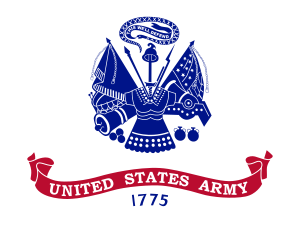Flag of the United States Army
 | |
| Use | Other |
|---|---|
| Proportion | 3:5 |
| Adopted | June 12, 1956[1] |
| Design | A blue replica of the War Office Seal set on a white field. Beneath the seal is a broad scarlet scroll bearing the inscription in white letters, "United States Army". Beneath the scroll, in blue Arabic numerals, is "1775". |
| Designed by | United States Army |
The flag of the United States Army displays a blue replica of the War Office Seal set on a white field. Beneath the seal is a broad scarlet scroll bearing the inscription in white letters, "United States Army". Beneath the scroll, in blue Arabic numerals, is "1775" the year in which the Continental Army was created with the appointment of General George Washington as Commander-in-Chief. All of this is on a white background.
The flag was officially adopted by U.S. President Dwight D. Eisenhower, on June 12, 1956, via Executive Order 10670.[1]
History

Prior to 1956 the Army was the only armed service without a flag to represent the entire service. In 1955, prompted by the need for a flag to represent the U.S. Army in joint service ceremonies, Secretary of the Army Wilber M. Brucker requested the creation of an army flag.
The U.S. Army flag was dedicated and unfurled to the general public on June 14, 1956 at Independence Hall, Philadelphia, on the 181st anniversary of the establishment of the U.S. Army by the Continental Congress. The original flag measured 4 feet 4 inches by 5 feet 6 inches, the flag is of white silk with a blue embroidered central design of the original War Office seal. "United States Army" is inscribed in white letters on a scarlet scroll, with the year "1775" in blue numerals below.
Streamers
The concept of campaign streamers began during the American Civil War, when the War Department instructed regiments to inscribe the names of their meritorious battles on their national colors. The Army has defined an official campaign as a particular combat action or series of actions that has historical significance or military importance to the Army and the nation. In 1890 the War Department directed that regimental honors be engraved on silver rings placed on the staffs of regimental flags. In 1920 the War Department ordered that each regimental color would bear streamers, in the colors of the campaign medal ribbon, for each campaign in which the regiment had fought. The creation of the Army Flag provided a means to display all the Army’s campaigns (175 in 2003).
The following campaign streamers are authorized for the U.S. Army colors, in order of precedence:[2][3]
| Streamers |
|---|
See also
- Flags of the United States Armed Forces
- United States Army Field Flag[21]
References
- ^ a b "Establishing a flag for the United States Army". Executive Order 10670. June 12, 1956. p. 324. Retrieved April 30, 2014.
WHEREAS the Secretary of the Army has adopted, and has recommended that I approve, an official flag for the United States Army, the design of which accompanies and is hereby made a part of this order, and which is described as follows: UNITED STATES ARMY FLAG--The flag for the United States Army is 4 feet 4 inches hoist by 5 feet 6 inches fly, of white silk or rayon, with yellow fringe, 2½ inches wide. In the center of the flag is the central design of the seal of the Department of the Army (without the Roman numerals) in ultramarine blue, above a scarlet scroll with the designation "UNITED STATES ARMY" in white, and beneath the scroll are the Arabic numerals "1775"; AND WHEREAS it appears that such flag is of suitable design and appropriate for adoption as the official flag of the United States Army: NOW, THEREFORE, by virtue of the authority vested in me as President of the United States, I hereby approve such flag as the official flag of the United States Army. On such official flags of the United States Army as the Secretary of the Army may designate, there shall be displayed below the spearhead of the flagstaff one streamer for each of the officially recognized campaigns in which the United States Army has participated. There shall be embroidered on each streamer the name of the campaign and the year in which it occurred.
- ^ Streamers, United States Army Institute of Heraldry
- ^ Streamers Documentation, Institute of Heraldry
- ^ Revolutionary War streamers
- ^ War of 1812 streamers
- ^ Mexican War streamers
- ^ Civil War streamers
- ^ Indian Wars streamers
- ^ Spanish American War streamers
- ^ China Relief Expedition streamers
- ^ Philippine Insurrection streamers
- ^ Mexican Expedition streamers
- ^ World War I streamers
- ^ WWII American Campaign streamers
- ^ WWII Asiatic-Pacific Campaign streamers
- ^ European-African-Middle Eastern Campaign streamers
- ^ Korean War streamers
- ^ Vietnam War streamers
- ^ Expeditionary streamers
- ^ Southwest Asian streamers
- ^ "United States Army Field Flag".
Further reading
 This article incorporates public domain material from The Origin of the U.S. Army Flag. United States Army Center of Military History.
This article incorporates public domain material from The Origin of the U.S. Army Flag. United States Army Center of Military History.
External links
- United States Army Flag: Short history of Army Flag at the U.S. Army Quartermaster Museum



